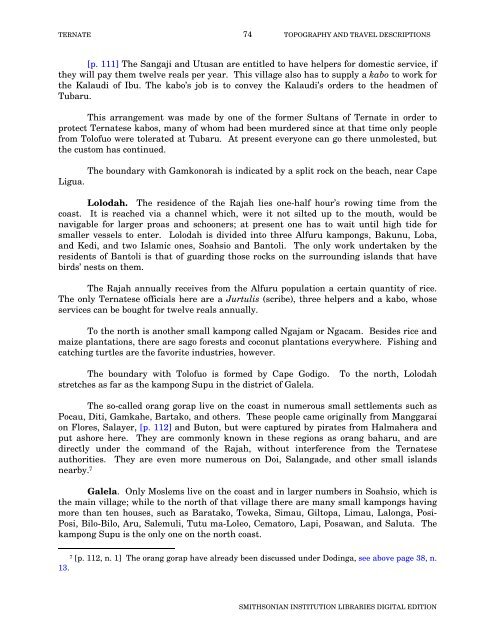Ternate - Smithsonian Institution Libraries
Ternate - Smithsonian Institution Libraries
Ternate - Smithsonian Institution Libraries
You also want an ePaper? Increase the reach of your titles
YUMPU automatically turns print PDFs into web optimized ePapers that Google loves.
TERNATE 74 TOPOGRAPHY AND TRAVEL DESCRIPTIONS<br />
[p. 111] The Sangaji and Utusan are entitled to have helpers for domestic service, if<br />
they will pay them twelve reals per year. This village also has to supply a kabo to work for<br />
the Kalaudi of Ibu. The kabo’s job is to convey the Kalaudi’s orders to the headmen of<br />
Tubaru.<br />
This arrangement was made by one of the former Sultans of <strong>Ternate</strong> in order to<br />
protect <strong>Ternate</strong>se kabos, many of whom had been murdered since at that time only people<br />
from Tolofuo were tolerated at Tubaru. At present everyone can go there unmolested, but<br />
the custom has continued.<br />
The boundary with Gamkonorah is indicated by a split rock on the beach, near Cape<br />
Ligua.<br />
Lolodah. The residence of the Rajah lies one-half hour’s rowing time from the<br />
coast. It is reached via a channel which, were it not silted up to the mouth, would be<br />
navigable for larger proas and schooners; at present one has to wait until high tide for<br />
smaller vessels to enter. Lolodah is divided into three Alfuru kampongs, Bakunu, Loba,<br />
and Kedi, and two Islamic ones, Soahsio and Bantoli. The only work undertaken by the<br />
residents of Bantoli is that of guarding those rocks on the surrounding islands that have<br />
birds’ nests on them.<br />
The Rajah annually receives from the Alfuru population a certain quantity of rice.<br />
The only <strong>Ternate</strong>se officials here are a Jurtulis (scribe), three helpers and a kabo, whose<br />
services can be bought for twelve reals annually.<br />
To the north is another small kampong called Ngajam or Ngacam. Besides rice and<br />
maize plantations, there are sago forests and coconut plantations everywhere. Fishing and<br />
catching turtles are the favorite industries, however.<br />
The boundary with Tolofuo is formed by Cape Godigo. To the north, Lolodah<br />
stretches as far as the kampong Supu in the district of Galela.<br />
The so-called orang gorap live on the coast in numerous small settlements such as<br />
Pocau, Diti, Gamkahe, Bartako, and others. These people came originally from Manggarai<br />
on Flores, Salayer, [p. 112] and Buton, but were captured by pirates from Halmahera and<br />
put ashore here. They are commonly known in these regions as orang baharu, and are<br />
directly under the command of the Rajah, without interference from the <strong>Ternate</strong>se<br />
authorities. They are even more numerous on Doi, Salangade, and other small islands<br />
nearby. 7<br />
Galela. Only Moslems live on the coast and in larger numbers in Soahsio, which is<br />
the main village; while to the north of that village there are many small kampongs having<br />
more than ten houses, such as Baratako, Toweka, Simau, Giltopa, Limau, Lalonga, Posi-<br />
Posi, Bilo-Bilo, Aru, Salemuli, Tutu ma-Loleo, Cematoro, Lapi, Posawan, and Saluta. The<br />
kampong Supu is the only one on the north coast.<br />
7 [p. 112, n. 1] The orang gorap have already been discussed under Dodinga, see above page 38, n.<br />
13.<br />
SMITHSONIAN INSTITUTION LIBRARIES DIGITAL EDITION

















